| House of Loredan-Santo Stefano | |
|---|---|
| Noble House | |
 Coat of Arms of the House of Loredan | |
| Parent family | |
| Country | |
| Earlier spellings | San Vitale |
| Etymology | from Campo Santo Stefano |
| Place of origin | |
| Founded | 14th century |
| Founder | Gerolamo Loredan di S. Vitale |
| Final ruler | Francesco Loredan |
| Final head | Andrea di Girolamo Loredan |
| Titles | Doge of Venice Dogaressa of Venice Procurator of St. Mark Lord of Barban and Rakalj and others |
| Style(s) | "His Serenity" |
| Members | |
| Distinctions | Golden Rose |
| Traditions | Roman Catholicism |
| Motto | NON NOBIS DOMINE NON NOBIS ("Praise us not, O Lord.") |
| Estate(s) | Barban and Rakalj, Istria |
| Properties | |
| Dissolution | 1767 |
The House of Loredan-Santo Stefano was a cadet branch of the House of Loredan that existed from the 14th century until 1767. The branch was mainly settled in the Palazzo Loredan in Campo Santo Stefano, which they acquired in 1536 from the Mocenigo family. The progenitor of the branch is considered to be Gerolamo Loredan "dal Barbaro" di S. Vitale (d.~1474), father of Doge Leonardo Loredan and Dogaressa Caterina Loredan. Besides Leonardo, the branch also gave Doge Francesco Loredan.[1]
History
The progenitor of the family is considered to be Gerolamo Loredan di S. Vitale (d.~1474), known as "dal Barbaro", who served as the podestà of Padua.[2] He married Donata Donà di Natale and their children were Doge Leonardo Loredan and Dogaressa Caterina Loredan, as well as Pietro Loredan (1466-1510), of poor health and unstable character, who studied alchemy in Padua and was disinterested in politics. In the will drawn up in February 1474 in Padua where he was podestà, the father designated Leonardo as the executor of the will and the sole heir of the estate and granted Pietro an annual annuity of 250 ducats.[2] Their sister, Caterina Loredan, who later became Dogaressa of Venice by marriage to Doge Antonio Grimani, was described in a book by Edgcumbe Staley: “The Loredanian tradition for patriotism and nobility was handed on in the gracious personage of Dogaressa Caterina Loredan, sister of Doge Leonardo Loredan – the Consort of his successor Doge Antonio Grimani.”[3]
In 1461, Leonardo Loredan married Giustina Giustiniani, of the wealthy branch of S. Moisè, with whom he had nine children: Lorenzo (who became Procurator of St. Mark's), Girolamo (the only one to continue the branch), Alvise, Vincenzo (died in Tripoli in 1499), Bernardo, Donata, Maria (wife of Giovanni Venier, of the branch that gave birth to Doge Francesco Venier), Paola (wife of Giovanni Alvise Venier, descendant of Doge Antonio Venier), and Elisabetta.[2]
The main line of the branch of Santo Stefano ended in 1750 with Andrea di Girolamo Loredan, who died young in 1750, and the branch became extinct in 1767 with the death of Giovanni Loredan, brother of Doge Francesco.[4]
Genealogy
| House of Loredan-Santo Stefano (Genealogy) | |||||||||||||||||||||||||||||||||||||||||||||||||||||||||||||||||||||||||||||||||||||||||||||||||||||||||||||||||||||||||||||||||||||||||||||||||||||||||||||||||||||||||||||||||||||||||||||||||||||||||||||||||||||||||||||||||||||||||||||||||||||||||||||||||||||||||||||||||||||||||||||||||||||||||||||||||||||||||||||||||||||||||||||||||||||||||||||||||||||||||||||||||||||||||||||||||||||||||||||||||||||||||||||||||||||||||||||||||||||||||||||||||||||||||||||||||||||||||||||||||||||||||||||||||||||||||||||||||||||||||||||||||||||||||||||||||||||||||||||||||||||||||||||||||||||||||||||||||||||||||||||||||||||||||||||||||||||||||||||||||||||||||||||||||||||||||||||||||||||||||||||||||||||||||||||||||||||||||||||||||||||||||||||||||||||||||||||||||||||||||||||||||||||||||||||||||||||||||||||||||||||||||||||||||||||||||||||||||||||||||||||||||||||||||||||||||||||||||||||||||||||||||||||||||||||||||||||||||||||||||||||||||||||||||||||||||||||||||||||||||||||||||||||||||||||||||||||||||||||||
|---|---|---|---|---|---|---|---|---|---|---|---|---|---|---|---|---|---|---|---|---|---|---|---|---|---|---|---|---|---|---|---|---|---|---|---|---|---|---|---|---|---|---|---|---|---|---|---|---|---|---|---|---|---|---|---|---|---|---|---|---|---|---|---|---|---|---|---|---|---|---|---|---|---|---|---|---|---|---|---|---|---|---|---|---|---|---|---|---|---|---|---|---|---|---|---|---|---|---|---|---|---|---|---|---|---|---|---|---|---|---|---|---|---|---|---|---|---|---|---|---|---|---|---|---|---|---|---|---|---|---|---|---|---|---|---|---|---|---|---|---|---|---|---|---|---|---|---|---|---|---|---|---|---|---|---|---|---|---|---|---|---|---|---|---|---|---|---|---|---|---|---|---|---|---|---|---|---|---|---|---|---|---|---|---|---|---|---|---|---|---|---|---|---|---|---|---|---|---|---|---|---|---|---|---|---|---|---|---|---|---|---|---|---|---|---|---|---|---|---|---|---|---|---|---|---|---|---|---|---|---|---|---|---|---|---|---|---|---|---|---|---|---|---|---|---|---|---|---|---|---|---|---|---|---|---|---|---|---|---|---|---|---|---|---|---|---|---|---|---|---|---|---|---|---|---|---|---|---|---|---|---|---|---|---|---|---|---|---|---|---|---|---|---|---|---|---|---|---|---|---|---|---|---|---|---|---|---|---|---|---|---|---|---|---|---|---|---|---|---|---|---|---|---|---|---|---|---|---|---|---|---|---|---|---|---|---|---|---|---|---|---|---|---|---|---|---|---|---|---|---|---|---|---|---|---|---|---|---|---|---|---|---|---|---|---|---|---|---|---|---|---|---|---|---|---|---|---|---|---|---|---|---|---|---|---|---|---|---|---|---|---|---|---|---|---|---|---|---|---|---|---|---|---|---|---|---|---|---|---|---|---|---|---|---|---|---|---|---|---|---|---|---|---|---|---|---|---|---|---|---|---|---|---|---|---|---|---|---|---|---|---|---|---|---|---|---|---|---|---|---|---|---|---|---|---|---|---|---|---|---|---|---|---|---|---|---|---|---|---|---|---|---|---|---|---|---|---|---|---|---|---|---|---|---|---|---|---|---|---|---|---|---|---|---|---|---|---|---|---|---|---|---|---|---|---|---|---|---|---|---|---|---|---|---|---|---|---|---|---|---|---|---|---|---|---|---|---|---|---|---|---|---|---|---|---|---|---|---|---|---|---|---|---|---|---|---|---|---|---|---|---|---|---|---|---|---|---|---|---|---|---|---|---|---|---|---|---|---|---|---|---|---|---|---|---|---|---|---|---|---|---|---|---|---|---|---|---|---|---|---|---|---|---|---|---|---|---|---|---|---|---|---|---|---|---|---|---|---|---|---|---|---|---|---|---|---|---|---|---|---|---|---|---|---|---|---|---|---|---|---|---|---|---|---|---|---|---|---|---|---|---|---|---|---|---|---|---|---|---|---|---|---|---|---|---|---|---|---|---|---|---|---|---|---|---|---|---|---|---|---|---|---|---|---|---|---|---|---|---|---|---|---|---|---|---|---|---|---|---|---|---|---|---|---|---|---|---|---|---|---|---|---|---|---|---|---|---|---|---|---|---|---|---|---|---|---|---|---|---|---|---|---|---|---|---|---|---|---|---|---|---|---|---|---|---|---|---|---|---|---|---|---|---|---|---|---|---|---|---|---|---|---|---|---|---|---|---|---|---|---|---|---|---|---|---|---|---|---|---|---|---|---|---|---|---|---|---|---|---|---|---|---|---|---|---|---|---|---|---|---|---|---|---|---|---|---|---|---|---|---|---|---|---|---|---|---|---|---|---|---|---|---|---|---|---|---|---|---|---|---|---|---|---|---|---|---|---|---|---|---|---|---|---|---|---|---|---|---|---|---|---|---|---|---|---|---|---|---|---|---|---|---|---|---|---|---|---|---|---|---|---|---|---|---|---|---|---|---|---|---|---|---|---|---|---|---|---|---|---|---|---|---|---|---|---|---|---|---|---|---|---|---|---|---|---|---|---|---|---|---|---|---|---|---|---|---|---|---|---|---|---|---|---|---|---|---|---|---|---|---|---|---|---|---|---|---|---|---|---|---|---|---|---|---|---|---|---|---|---|---|---|---|---|---|---|---|---|---|---|---|---|---|---|---|---|---|---|---|---|---|---|---|---|---|---|---|---|---|---|---|---|---|---|---|---|---|---|---|---|---|---|---|---|---|---|---|---|---|---|---|---|---|---|---|---|---|---|---|---|
| |||||||||||||||||||||||||||||||||||||||||||||||||||||||||||||||||||||||||||||||||||||||||||||||||||||||||||||||||||||||||||||||||||||||||||||||||||||||||||||||||||||||||||||||||||||||||||||||||||||||||||||||||||||||||||||||||||||||||||||||||||||||||||||||||||||||||||||||||||||||||||||||||||||||||||||||||||||||||||||||||||||||||||||||||||||||||||||||||||||||||||||||||||||||||||||||||||||||||||||||||||||||||||||||||||||||||||||||||||||||||||||||||||||||||||||||||||||||||||||||||||||||||||||||||||||||||||||||||||||||||||||||||||||||||||||||||||||||||||||||||||||||||||||||||||||||||||||||||||||||||||||||||||||||||||||||||||||||||||||||||||||||||||||||||||||||||||||||||||||||||||||||||||||||||||||||||||||||||||||||||||||||||||||||||||||||||||||||||||||||||||||||||||||||||||||||||||||||||||||||||||||||||||||||||||||||||||||||||||||||||||||||||||||||||||||||||||||||||||||||||||||||||||||||||||||||||||||||||||||||||||||||||||||||||||||||||||||||||||||||||||||||||||||||||||||||||||||||||||||||
Note: The branch of Santo Stefano is also known as the branch of San Vidal (San Vitale).[e]
Note: There are some generations missing between Girolamo Loredan (1468-1532) and Francesco Loredan (17th century).
Note: Giustina Giustiniani (d. 1500), the wife of Doge Leonardo Loredan (1436-1521), is also known as Morosina Giustiniani.
Note: Caterina Loredan, Dogaressa of Venice, is featured in the family tree as the daughter of Gerolamo Loredan (d. 1474) and Donata Donà because, in some sources, she is mentioned as the sister of Doge Leonardo Loredan (1436-1521), although she may have been a daughter of Domenico Loredan.
Interestingly, near the Palazzo Contarini-Sceriman and the nearby bridge, Leonardo Loredan (d. 1675) was found dead in a boat. The unexplained death was the source of many rumors, claiming accidental death, murder by relatives, or murder by the Inquisitors of the Republic.
Andrea Loredan (d. 1750) died young, thus ending the male (agnatic) line of the branch of Santo Stefano.
Istria
Barban and Rakalj
On the 23rd of December, 1535, the Loredan family acquired the town of Barban in Istria (today part of Croatia) for 14,760 ducats, and ownership was held by the brothers Leonardo, Lorenzo and Francesco, of the Santo Stefano branch. At the time, Barban also included Rakalj, and the two territories were organized as a separate feud owned by the Loredan family, who owned it until the abolition of feudal rights in 1869.[5]
 Loredan coat of arms in Barban
Loredan coat of arms in Barban Loredan coat of arms in Barban
Loredan coat of arms in Barban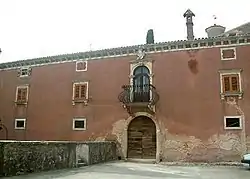 Loredan Palace in Barban
Loredan Palace in Barban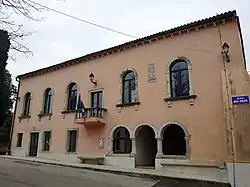 Loredan Palace in Rakalj
Loredan Palace in Rakalj
The Loredan Terminations
“The Loredan Terminations” were written orders of the Loredan family. They were created for the purpose of communication between the masters who were in Venice and the family representatives in Istria. From them we can learn about the internal structure of the feud. The captain had political and judicial power, and was appointed by the Loredans. He had to reside permanently on the estate and participate in the election of prefects, deputy prefects and other officials. He had a chancellor who recorded all the documents in special books, and he also took care of the distribution of grain. Twelve judges, the prefect and the deputy prefect took care of the supply, solved smaller disputes and imposed lesser sentences. Church and fraternal goods were managed by the gastald and the municipal money was collected by the chamberlain.[6]
The Terminations are kept in the Croatian State Archives in Rijeka.[6]
Palazzo Loredan in Campo Santo Stefano
Palazzo Loredan in Campo Santo Stefano, where the branch was settled, is a palace in the San Marco district of Venice, overlooking Campo Santo Stefano.
Before the acquisition by the Loredan family in 1536 and the restoration by the architect Antonio Abbondi, it was a group of adjacent buildings, in the Gothic style, belonging to the Mocenigo family. The purchased buildings were substantially restored and made into a single building for the residence of the Loredan family.
After the fall of the Republic of Venice, a Loredan heir sold the building to a businessman around 1802–1805.
Today, the palace is the seat of the Venetian Institute of Science, Literature and Arts and it houses the Panteon Veneto, a collection of sculptures of great Venetians.[7]
Family in art
In painting



 Portrait of Doge Leonardo Loredan, by Francesco Maggiotto, 18th century
Portrait of Doge Leonardo Loredan, by Francesco Maggiotto, 18th century_Allegoria_della_vittoria_sulla_Lega_di_Cambrai_-_Palma_il_Giovane_-_Doge_Leonardo_Loredan.jpg.webp) Allegory of the Victory over the League of Cambrai, by Palma il Giovane, 1590, featuring Doge Leonardo Loredan, Doge's Palace, Venice
Allegory of the Victory over the League of Cambrai, by Palma il Giovane, 1590, featuring Doge Leonardo Loredan, Doge's Palace, Venice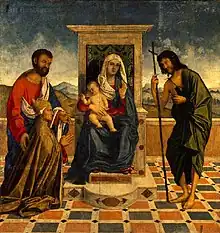 The Virgin with Child and Saints adored by Doge Leonardo Loredan, by Vincenzo Catena, 1506, Doge's Palace, Venice
The Virgin with Child and Saints adored by Doge Leonardo Loredan, by Vincenzo Catena, 1506, Doge's Palace, Venice Doge Leonardo Loredan Giving Copies of the Laws of Venice to the Ambassadors from Nuremberg, by Carlo and Gabriele Caliari, 1588, Doge's Palace, Venice
Doge Leonardo Loredan Giving Copies of the Laws of Venice to the Ambassadors from Nuremberg, by Carlo and Gabriele Caliari, 1588, Doge's Palace, Venice Doge Leonardo Loredan Handing a Parchment to Zauli Naldi, 1504, Manfrediana Library, Faenza
Doge Leonardo Loredan Handing a Parchment to Zauli Naldi, 1504, Manfrediana Library, Faenza Portrait of Doge Leonardo Loredan, 16th century
Portrait of Doge Leonardo Loredan, 16th century Portrait of Doge Leonardo Loredan, 16th century
Portrait of Doge Leonardo Loredan, 16th century

 The Triumph of Venice, by Pompeo Batoni, 1737, featuring Doge Leonardo Loredan, North Carolina Museum of Art, Raleigh
The Triumph of Venice, by Pompeo Batoni, 1737, featuring Doge Leonardo Loredan, North Carolina Museum of Art, Raleigh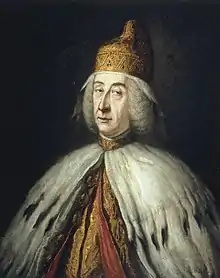 Portrait of Doge Francesco Loredan, by Fortunato Pasquetti
Portrait of Doge Francesco Loredan, by Fortunato Pasquetti Portrait of Doge Francesco Loredan, by Jacopo Guarana
Portrait of Doge Francesco Loredan, by Jacopo Guarana Portrait of Doge Francesco Loredan, by Antonio Nani
Portrait of Doge Francesco Loredan, by Antonio Nani
In sculpture
_-_Statue_of_doge_Leonardo_Loredan.jpg.webp) Statue of Doge Leonardo Loredan, by Girolamo Campagna, 1572, Basilica of Santi Giovanni e Paolo, Venice
Statue of Doge Leonardo Loredan, by Girolamo Campagna, 1572, Basilica of Santi Giovanni e Paolo, Venice
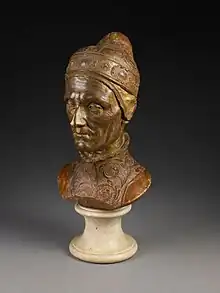
 Doge Leonardo Loredan at the Feet of the Virgin with Saints, by Pietro Lombardo, Doge's Palace, Venice
Doge Leonardo Loredan at the Feet of the Virgin with Saints, by Pietro Lombardo, Doge's Palace, Venice_-_Monument_of_doge_Leonardo_Loredan.jpg.webp) Tomb of Doge Leonardo Loredan, by Girolamo Grapiglia, 1572, Basilica of Santi Giovanni e Paolo, Venice
Tomb of Doge Leonardo Loredan, by Girolamo Grapiglia, 1572, Basilica of Santi Giovanni e Paolo, Venice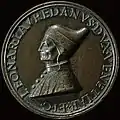
References
- ↑ Manfroni, Camillo (1934). Enciclopedia Italiana (in Italian).
- 1 2 3 "LOREDAN, Leonardo in "Dizionario Biografico"". www.treccani.it (in Italian). Retrieved 2021-02-24.
- ↑ Staley, Edgcumbe (1910). The Dogaressas of Venice: The Wives of the Doges. London: T.W. Laurie.
- ↑ "LOREDAN in "Enciclopedia Italiana"". www.treccani.it (in Italian). Retrieved 2021-02-24.
- ↑ Bertoša, Slaven (2012). Gli Orizzonti Mediterranei della Famiglia Veneziana Loredan (in Italian).
- 1 2 Bertoša, Slaven (2015). Istarska enciklopedija (in Croatian).
- ↑ "Istituto Veneto" (PDF).
